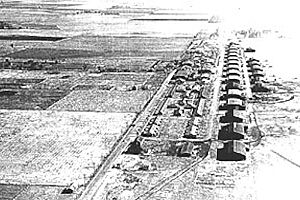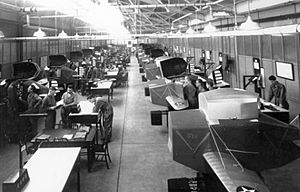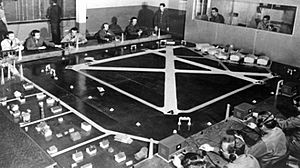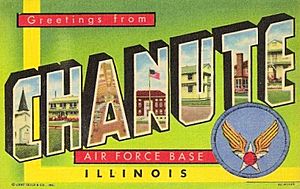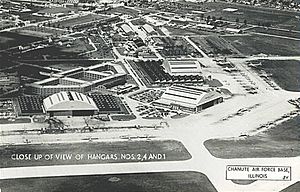Chanute Air Force Base facts for kids
Quick facts for kids Chanute Air Force BaseChanute Field |
|
|---|---|
| Located in Rantoul, Illinois | |

Chanute Field, Illinois, 12 November 1939. Note the lack of concrete runways.
|
|
| Coordinates | 40°17′40″N 088°08′35″W / 40.29444°N 88.14306°W |
| Type | Air Force Base |
| Site information | |
| Controlled by | |
| Site history | |
| Built | 1917 |
| In use | 1917–1993 |
| Battles/wars | World War I World War II |
| Garrison information | |
| Garrison | 3345th Air Base Group, (1948–1993) |
Chanute Air Force Base was a special place where the United States Air Force trained its people. It was located in Rantoul, Illinois, about 130 miles south of Chicago. For most of its history, Chanute's main job was to teach Air Force members important technical skills.
The base was first opened on May 21, 1917, and was called Chanute Field. It was one of many training camps set up when the United States joined World War I. Chanute Air Force Base closed in 1993. Today, the land is being used for other things, like businesses and community spaces.
Contents
Who Was Octave Chanute?
Chanute Field was named after Octave Chanute (1832–1910). He was a smart engineer who helped design early flying machines. He was also a friend and advisor to the Wright brothers, who invented the airplane.
Chanute designed a biplane glider in 1896. It had two arched wings held together by strong supports. This design was very important and helped inspire the first airplanes.
A Look Back: Chanute's History
Chanute in World War I
When World War I started in Europe, the United States didn't have a strong air force. In April 1917, America had only one main air squadron and about 250 aircraft. France, for example, had over 1,500 planes when the war began.
To catch up, the U.S. government spent a lot of money to build up its air power. They opened training schools and flying fields. Rantoul, Illinois, was chosen for a new field because it had flat land, was close to a railroad, and near the University of Illinois where pilots could study. The town of Rantoul also provided electricity and water.
Construction of Chanute Field began on May 25, 1917. At its busiest, 2,000 workers and many machines were building the base. This brought a lot of money and people to the small town of Rantoul. The first commander, Captain Charles C. Benedict, arrived in late June. On July 4, the first airplanes landed at the new base.
Major James L. Dunsworth took command on July 15, 1917. He ordered flight training to start right away. Pilots began flying Curtiss JN-4 "Jenny" trainer planes from morning until night. The airfield was finished on July 22, 1917, costing about $1 million. It officially opened on July 31.
Chanute Field became a main flying school. It offered an eight-week course for new pilot trainees. It could train up to 300 students at a time. By the end of World War I in November 1918, Chanute Field had trained thousands of pilots. After the war, pilot training stopped. The base then became a storage place for aircraft engines and paint.
Between the World Wars
After World War I, the U.S. Army Air Service became much smaller. Many soldiers were sent home, and hundreds of small flying fields closed. In 1919, there was talk of closing Chanute Field too. However, in 1920, Congress approved money to buy the base.
By 1920, many of the buildings, which were quickly built during the war, were falling apart. But on January 4, 1921, Chanute was given a new important job. The Air Service Mechanics School moved there from Texas. This meant all technical training for the Air Service would happen at Chanute.
In 1922, schools for photography and communications also moved to Chanute. This brought all technical training together in one place. From 1922 to 1938, Chanute Field was the only place for all technical training for the U.S. Army Air Corps.
Many new buildings were constructed at Chanute starting in 1938. Most of the old buildings were made of wood, so fires were a big problem. The Army Air Corps decided to rebuild Chanute as one of four bases.
By 1939, new hangars, a headquarters building, a hospital, barracks, and a water tower were finished. This cost $13.8 million, mostly paid for by President Roosevelt's Works Progress Administration (WPA). More hangars, theaters, and concrete runways were added. These projects were completed in 1941, just before the attack on Pearl Harbor.
In 1941, the Technical Training Command was created at Chanute Field. This new command was in charge of all technical training for enlisted men and officers. The headquarters later moved to Tulsa, Oklahoma.
Chanute in World War II
After Japan attacked Pearl Harbor in December 1941, many people joined the U.S. Army Air Forces. Chanute Field quickly changed from a peaceful training base to a busy wartime one. The base still focused on technical training, but so many new recruits arrived that there wasn't enough housing. Many soldiers had to live in large tents. By January 1943, Chanute had a peak of 25,000 students.
The Women's Army Corps School also opened at Chanute in 1944. The town of Rantoul helped the base by opening their homes to soldiers and supporting war efforts. Local groups also created centers for soldiers to relax.
Towards the end of 1944, helicopter training moved to Chanute Field. This allowed helicopter pilot training and mechanic training to be together. After September 1945, Chanute Field became a place where soldiers were processed to return to civilian life after the war.
The Tuskegee Airmen
On March 22, 1941, the first all-black fighter squadron was formed at Chanute Field. This was the 99th Pursuit Squadron, which became part of the famous Tuskegee Airmen. Over 250 enlisted men were trained at Chanute. They learned skills like airplane mechanics, supply work, and weather forecasting. These men became the core of other black squadrons that formed later.
Chanute as an Air Force Base
After World War II, on January 14, 1948, Chanute Field became Chanute Air Force Base. This happened when the United States Air Force became its own separate military branch. At this time, Chanute also started teaching about new jet engines. One of the first courses was for jet engine mechanics. By mid-1948, almost half of Chanute's students were taking this course.
In 1949, a new unit was formed to provide training for maintenance workers on different types of aircraft. This unit grew very large and helped create a new training program for Air Force Bases around the world.
The Korean War, which started in June 1950, greatly increased the training needs at Chanute. In 1949, there were about 5,235 students. By 1953, almost 12,000 students were at Chanute for important training. Chanute also helped process thousands of volunteer reservists who joined the military.
In the early 1960s, Chanute took over a program that taught foreign languages to Air Force personnel. This program covered 59 different languages.
During the 1960s, Chanute became a key training center for the LGM-30 Minuteman missile program. These ICBMs were very important for defending America. In 1970, the Minuteman missile launch officer course moved to Vandenberg AFB, California. Chanute also trained thousands of airmen from other countries during this time.
In the 1970s, Chanute trained many Air Force members for service in Vietnam. The base improved living conditions for students by building new dorms. In 1971, the base's active runway was closed because it was no longer needed for training. Chanute also became a main training center for the Air-Launched Cruise Missile (ALCM) in 1977. It was also involved in training for other missile programs.
In the late 1970s and 1980s, Chanute updated its training for new aircraft and engine technologies. For example, they received new jet engines to teach students about the engines used in modern fighter jets. Chanute also worked to improve its technical training programs by combining different divisions.
Chanute Air Force Base was a major training facility for many Air Force jobs. This included aircraft maintenance officers, meteorology (weather) personnel for the Air Force, Navy, and Marine Corps, and enlisted technical training for firefighters, aircraft maintenance, flight simulator maintenance, fuel system maintenance, and ICBM missile maintenance.
Chanute AFB also had special training facilities, like mock ICBM launch silos, for missile maintenance personnel. After Chanute AFB closed, this training moved to Vandenberg AFB, California. The base also trained Air Force firefighters and specialists in life support equipment, welding, and vehicle maintenance.
The Base Closes Down
On December 29, 1988, the Department of Defense suggested closing Chanute Air Force Base. This was part of a plan to reduce the size of the armed forces after the end of the Cold War.
Chanute officially closed on September 30, 1993. It was the third oldest active base in the USAF and the oldest Technical Training Center. Even before the base closed, the town of Rantoul began making plans to use the land for civilian purposes. Leaders from Rantoul worked hard to attract new businesses to the former base.
Names of the Facility
- Rantoul Aviation Field, May 21, 1917
- Chanute Field, June 6, 1917
- Chanute Air Force Base, January 13, 1948 – September 30, 1993
What Chanute Is Like Today
Many parts of the former Chanute Air Force Base have been changed for civilian use. Old Air Force buildings are now motels, retirement communities, restaurants, a fitness center, and manufacturing facilities. The golf course, once only for military members, is now open to everyone. The houses where airmen and their families lived are now occupied by civilians.
The old airfield and hangars are now a public airport called the Rantoul National Aviation Center / Frank Elliott Field. This name honors Major General Frank Worth Elliott, Jr., who helped with the base's redevelopment. There was also a museum, the Octave Chanute Aerospace Museum, which told the base's military history, but it closed in 2015.
A program called Lincoln's ChalleNGe Academy helps troubled young people aged 16–18. It is run by the Illinois Army National Guard and the Illinois Air National Guard in some of the former Chanute AFB buildings.
In 2019, the World Championship Punkin Chunkin competition planned to be held at the base.
Environmental Concerns
Chanute has been named an EPA Superfund site. This means there are areas of pollution from chemicals like volatile organic compounds, pesticides, and metals in the soil and groundwater. The State of Illinois has also found contamination at the site.


